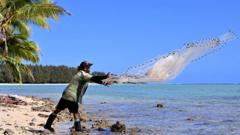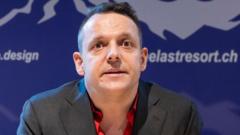Construction of the Fehmarnbelt tunnel will create the world’s longest pre-fabricated road and rail tunnel, linking Denmark to Germany and slashing travel times across Scandinavia.
Record-Breaking Baltic Sea Tunnel Set to Transform Scandinavian Travel

Record-Breaking Baltic Sea Tunnel Set to Transform Scandinavian Travel
A monumental engineering project under the Baltic Sea aims to enhance connectivity between Denmark and Germany.
The Baltic Sea is witnessing a groundbreaking development as the construction of the Fehmarnbelt tunnel progresses. This ambitious project, which runs 18 kilometers (11 miles) under the Baltic, will establish the world’s longest pre-fabricated road and rail tunnel, significantly reducing travel times and strengthening transport links between Denmark and Germany.
Located at the northern portal on the island of Lolland, the tunnel’s construction site spans more than 500 hectares (approximately 1,235 acres) and features a harbor and manufacturing facility responsible for producing the tunnel's segments, known as "elements." Henrik Vincentsen, the chief executive of Femern, the state-owned company overseeing the endeavor, noted, "It’s a huge facility here," underscoring the scale of the project.
Each element, measuring 217 meters (712 feet) in length and 42 meters in width, is created from reinforced steel and concrete. Unlike traditional underwater tunnels, the Fehmarnbelt tunnel will see 90 segments connected on the seafloor, much like joining Lego bricks. "We are breaking records with this project," Vincentsen exclaimed, highlighting the unprecedented scale of this immersed tunnel.
With an estimated cost of €7.4 billion ($8.1 billion; £6.3 billion), this monumental infrastructure project is primarily funded by Denmark, with €1.3 billion provided by the European Commission. As part of a broader EU initiative to enhance continental travel while minimizing carbon footprint, the tunnel is expected to drastically reduce the duration of the journey between Rødbyhavn in Denmark and Puttgarten in Germany, cutting travel time from a 45-minute ferry ride to just 10 minutes by car or 7 by train.
The new rail link will allow for journeys between Copenhagen and Hamburg to be completed in just 2.5 hours, effectively halving current travel times and offering a more environmentally friendly alternative for freight and passenger transport. "It's not just linking Denmark to Germany; it's linking Scandinavia to central Europe," stated Vincentsen, emphasizing the project's broad significance.
As construction progresses, senior construction manager Anders Gert Wede elaborated on the structure's intricacies, noting its five parallel tubes—two for railway lines, two for roads, and one for maintenance—within each element. The massive segments, weighing over 73,000 tons, undergo an elaborate process to be towed into place at sea, utilizing GPS and underwater cameras to ensure precise alignment.
Initially, alternatives like a bridge were considered, but environmental and security concerns led to the decision to construct a tunnel. Although the project faced opposition from ferry operators and conservationists worried about ecological disruption, a German federal court ultimately approved the plans, paving the way for construction.
To mitigate environmental impact, initiatives to protect local habitats have been implemented, including the establishment of a 300-hectare wetland area on reclaimed land. Once the tunnel is operational in 2029, projections indicate that over 100 trains and 12,000 cars will utilize it daily. The funding mechanism will involve revenue from toll fees to repay state-backed loans, with an estimated repayment period of around four decades. Vincentsen anticipates a positive economic boost, anticipating job creation and increased tourism in Lolland, one of Denmark's less affluent areas, which local residents have eagerly awaited.
Overall, this unprecedented infrastructure development symbolizes a major step toward enhanced connectivity and environmental sustainability in Europe.
Located at the northern portal on the island of Lolland, the tunnel’s construction site spans more than 500 hectares (approximately 1,235 acres) and features a harbor and manufacturing facility responsible for producing the tunnel's segments, known as "elements." Henrik Vincentsen, the chief executive of Femern, the state-owned company overseeing the endeavor, noted, "It’s a huge facility here," underscoring the scale of the project.
Each element, measuring 217 meters (712 feet) in length and 42 meters in width, is created from reinforced steel and concrete. Unlike traditional underwater tunnels, the Fehmarnbelt tunnel will see 90 segments connected on the seafloor, much like joining Lego bricks. "We are breaking records with this project," Vincentsen exclaimed, highlighting the unprecedented scale of this immersed tunnel.
With an estimated cost of €7.4 billion ($8.1 billion; £6.3 billion), this monumental infrastructure project is primarily funded by Denmark, with €1.3 billion provided by the European Commission. As part of a broader EU initiative to enhance continental travel while minimizing carbon footprint, the tunnel is expected to drastically reduce the duration of the journey between Rødbyhavn in Denmark and Puttgarten in Germany, cutting travel time from a 45-minute ferry ride to just 10 minutes by car or 7 by train.
The new rail link will allow for journeys between Copenhagen and Hamburg to be completed in just 2.5 hours, effectively halving current travel times and offering a more environmentally friendly alternative for freight and passenger transport. "It's not just linking Denmark to Germany; it's linking Scandinavia to central Europe," stated Vincentsen, emphasizing the project's broad significance.
As construction progresses, senior construction manager Anders Gert Wede elaborated on the structure's intricacies, noting its five parallel tubes—two for railway lines, two for roads, and one for maintenance—within each element. The massive segments, weighing over 73,000 tons, undergo an elaborate process to be towed into place at sea, utilizing GPS and underwater cameras to ensure precise alignment.
Initially, alternatives like a bridge were considered, but environmental and security concerns led to the decision to construct a tunnel. Although the project faced opposition from ferry operators and conservationists worried about ecological disruption, a German federal court ultimately approved the plans, paving the way for construction.
To mitigate environmental impact, initiatives to protect local habitats have been implemented, including the establishment of a 300-hectare wetland area on reclaimed land. Once the tunnel is operational in 2029, projections indicate that over 100 trains and 12,000 cars will utilize it daily. The funding mechanism will involve revenue from toll fees to repay state-backed loans, with an estimated repayment period of around four decades. Vincentsen anticipates a positive economic boost, anticipating job creation and increased tourism in Lolland, one of Denmark's less affluent areas, which local residents have eagerly awaited.
Overall, this unprecedented infrastructure development symbolizes a major step toward enhanced connectivity and environmental sustainability in Europe.




















